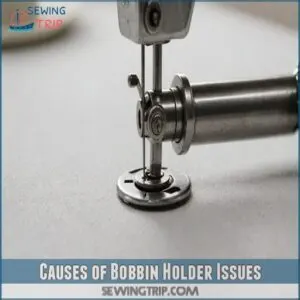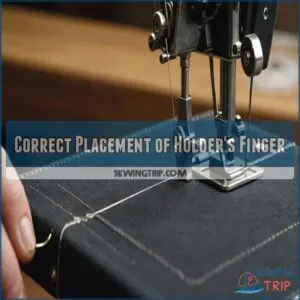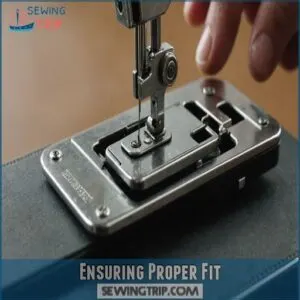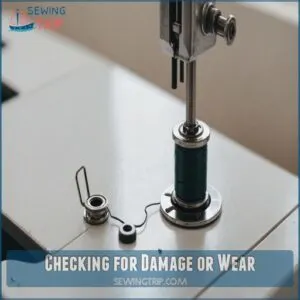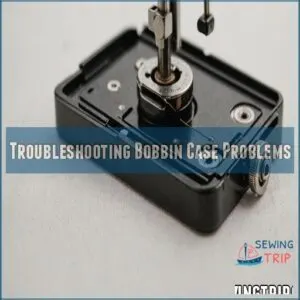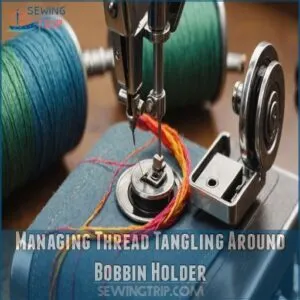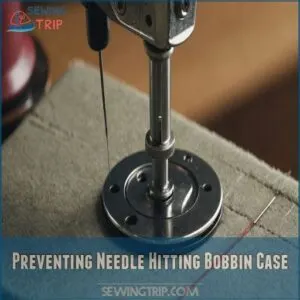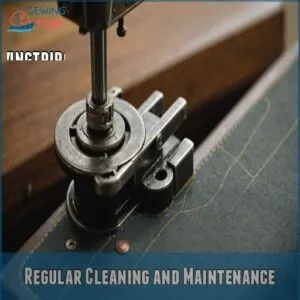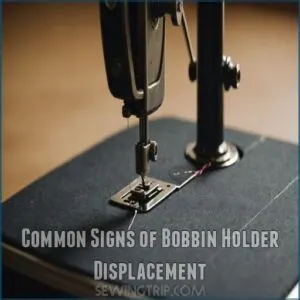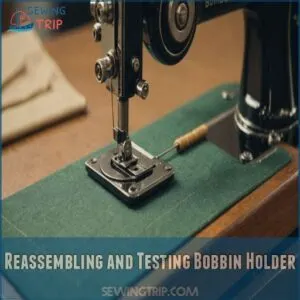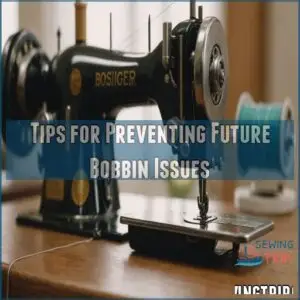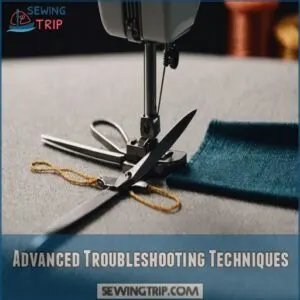This site is supported by our readers. We may earn a commission, at no cost to you, if you purchase through links.
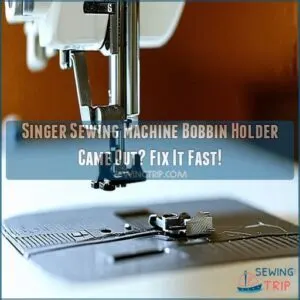
First, turn off your machine for safety.
Inspect the area for debris and damage.
The holder’s finger should fit snugly into the machine’s groove.
Gently reinsert the bobbin case, ensuring it clicks into place.
If it’s loose, you might need to tighten the screw holding it.
Clean the area with a soft brush to prevent future issues.
Remember, a well-maintained bobbin holder is key to smooth sewing.
If you’re still struggling, don’t force it – improper placement can cause more problems.
There’s more to learn about keeping your Singer in top shape, including some surprising tips that’ll save you time and frustration.
Table Of Contents
- Key Takeaways
- Causes of Bobbin Holder Issues
- Checking and Reinserting Bobbin Holder
- Troubleshooting Bobbin Case Problems
- Managing Thread Tangling Around Bobbin Holder
- Preventing Needle Hitting Bobbin Case
- Regular Cleaning and Maintenance
- Common Signs of Bobbin Holder Displacement
- Reassembling and Testing Bobbin Holder
- Tips for Preventing Future Bobbin Issues
- Advanced Troubleshooting Techniques
- Frequently Asked Questions (FAQs)
- Conclusion
Key Takeaways
- Check the bobbin holder’s finger fits snugly in the groove by the needle plate, ensuring proper alignment and preventing future displacement.
- Clean your machine regularly, removing lint and debris from the bobbin case and holder to prevent clogging and maintain smooth operation.
- Use high-quality thread and bobbins suitable for your Singer model to minimize tension issues and extend the lifespan of your machine’s components.
- If you’re still struggling after basic troubleshooting, consult your machine’s user manual or seek professional assistance to avoid causing further damage.
Causes of Bobbin Holder Issues
When your Singer sewing machine‘s bobbin holder acts up, it’s often due to dirt, using the wrong bobbin case, or missing the holder’s finger groove. In many cases, the root cause of the issue can be found in bobbin tension problems, such as unevenly wound bobbins, which can lead to uneven stitches or machine jams.
Regular cleaning and ensuring everything fits snugly can prevent these issues and keep your machine running smoothly.
Dirt and Debris Accumulation
Dirt and debris accumulation in your sewing machine can lead to annoying bobbin holder issues.
Lint buildup disrupts smooth operation and may shorten your machine’s lifespan.
For effective sewing machine maintenance, regularly follow cleaning tips: use a small brush to remove debris, and apply compressed air to combat pesky clogs.
Regular sewing machine cleaning helps maintain consistent performance and keeps those bobbin case issues at bay.
Incorrect Bobbin Case Type
Sometimes, even after cleaning, your bobbin holder still won’t fit. This might mean you’re using the wrong bobbin case. Check your Singer 1304 sewing machine manual for bobbin case compatibility.
- Is your bobbin case the right type?
- Does it match your machine’s model?
- Consult a Singer 1304 compatibility chart.
Using the correct bobbin case is key for smooth sewing.
A wrong case leads to frustrating fits and poor stitching.
Double-check your bobbin case type.
Forgetting to Place Holder’s Finger
Leaving the bobbin holder‘s finger outside its groove can cause sewing machine errors.
This tiny detail often leads to issues with the bobbin holder mechanism, which can be caused by misalignment, latch functionality, or guide positioning, as explained in Janome Bobbin Holder Problems, and this often leads to bobbin holder problems in the Singer 1304.
Always make sure it fits snugly into the groove.
Here’s a quick guide to help visualize:
| Common Mistake | Troubleshooting Tips |
|---|---|
| Wrong bobbin placement | Check holder’s alignment |
| Ignoring finger’s role | Make sure it fits the groove |
| Misaligned holder | Reinsert carefully |
| Skipping checks | Regular maintenance helps |
Checking and Reinserting Bobbin Holder
To check and reinsert your bobbin holder, make sure the holder’s finger fits snugly in the small groove by the needle plate.
Inspect for any damage or wear, and verify that it sits correctly to prevent future sewing mishaps.
Correct Placement of Holder’s Finger
A little trick to mastering your Singer sewing machine is ensuring the bobbin holder’s finger aligns perfectly with the groove by the needle plate.
For more precision, you can find specialized tools, such as those for Bobbin holder finger alignment, to help with this process.
This placement, essential for bobbin case compatibility, helps maintain consistent bobbin tension, preventing pesky bobbin issues.
Remember, checking this alignment regularly is one of the best sewing machine maintenance tips you can adopt!
Ensuring Proper Fit
After securing the holder’s finger, make sure your bobbin holder is perfectly sized and positioned in its slot.
It should sit without wobbling.
Refer to your sewing machine diagram for guidance.
The case needs to fit snugly, neither too tight nor too loose.
Verify that the presser foot is compatible with your sewing machine model for seamless operation.
Checking for Damage or Wear
You’ve got the bobbin all snug now, but it’s smart to inspect for damage.
Look closely for bobbin holder cracks or a worn spring.
Check case alignment; a loose bobbin case might cause needle damage.
Don’t let bobbin wear or improper bobbin winding mess up your project.
Address these signs promptly to avoid sewing machine repair woes.
Troubleshooting Bobbin Case Problems
You might notice your sewing machine is struggling if your bobbin case has issues with clogging or tension spring settings.
Tackle these problems by routinely checking for debris buildup and adjusting the tension spring for a secure fit.
Clogging and Tension Spring Issues
Okay, so you’ve got your bobbin holder back in place. Now, let’s tackle bobbin case problems. Sometimes, dirt and thread clog things up. A too-tight tension spring also causes issues.
To avoid such problems, you should regularly inspect and clean your bobbin case for signs of damage, such as nicks or bends, as well as consider thread types and weights.
Here’s what to check:
- Is your bobbin case jammed with lint?
- Is the spring too tight, causing tension problems?
- Have you cleaned the bobbin case thoroughly?
- Check your sewing machine manual for specific instructions. Cleaning is key! A little preventative maintenance goes a long way.
Adjusting Tension Spring
Adjusting the tension spring can feel like tuning an instrument.
When working with your Singer 1304 sewing machine, it’s essential to understand the role of bobbins and their cases. Find the tiny screw on your Singer 1304 sewing machine’s bobbin case.
Turn it slightly clockwise for tighter tension, counterclockwise to loosen.
The right balance stops those annoying thread tangles.
It’s all about patience—tiny turns make a big difference in achieving smooth sewing machine operation.
Reattaching Bobbin Case
After managing the tension spring, focus on securely reattaching the bobbin case to your Singer 1304.
Align the bobbin case properly, ensuring it fits snugly by checking the bobbin case latch and alignment.
If you’re unsure, refer to your sewing machine manual for guidance.
A well-placed bobbin case prevents future sewing mishaps, ensuring smooth operation every time.
Managing Thread Tangling Around Bobbin Holder
Thread tangling around the bobbin holder can be frustrating, but with the right techniques, you can keep your sewing smooth.
Start by ensuring the machine is threaded correctly, which prevents frustrating knots and snags that can interrupt your sewing flow.
Correct Threading Techniques
Thread path variations can seem overwhelming, but managing them is really important for smooth sewing on your Singer 1304.
Make sure your thread follows the correct path through thread guides and tighten the spool thread tension just right.
Proper bobbin winding prevents winding issues, so double-check the bobbin case placement.
These steps eliminate frustrating sewing machine troubleshooting and make sure a perfectly spinning bobbin.
Preventing Thread Tangling
Managing thread tangling around your Singer 1304’s bobbin holder is important for smooth sewing.
Make sure your thread tension is properly set, matching your spool type and needle size.
Guide the thread carefully through all thread guides, maintaining even bobbin tension.
Regularly cleaning your sewing machine helps prevent buildup that can cause tangling, making troubleshooting easier and sewing more enjoyable.
Thread Removal Techniques
Don’t let thread tangles cause you stress. To tackle them effectively, begin with these simple steps. First, cut away visible threads around the bobbin case. Next, gently remove the bobbin and needle for full access. Finally, carefully pull any lingering threads without damaging the fabric.
- Inspect the manual for guidance
- Check for thread tension issues
- Perform regular maintenance
Preventing Needle Hitting Bobbin Case
A needle hitting the bobbin case can also be caused by a stuck or stiff spindle, which may be due to a thread jam, lint buildup, or old oil gumming up the works, such as those Common Bobbin Winding Problems. A needle hitting the bobbin case is a common sewing machine problem, often caused by incorrect bobbin placement or tension.
Let’s prevent this by carefully checking the bobbin case’s position, ensuring correct needle placement, and adjusting your presser foot and tension settings for a smooth sewing experience.
Correct Needle Placement
Tangling threads can be frustrating, but let’s focus on needle placement next.
Making sure you have the correct needle size, type, and orientation in your Singer 1304 sewing machine prevents it from hitting the bobbin case.
Remember to check needle depth to avoid breakage.
Here’s a handy guide:
| Factor | Check |
|---|---|
| Needle Size | Match fabric and thread |
| Needle Type | Verify for particular materials |
| Needle Depth | Make sure it’s fully inserted and tightened |
Checking Bobbin Case Position
Sometimes, it’s tricky to make sure your Singer 1304’s bobbin case is perfectly aligned.
Start by checking if the bobbin case latch is securely closed to avoid needle hits.
Make sure the bobbin holder groove is snugly fit and case placement is spot-on.
Additionally, to prevent issues with the bobbin case, make sure to check the bobbin thread tension as improper tension can cause problems with the bobbin case.
Consult the sewing machine manual for precise bobbin case alignment, enhancing your sewing experience without hiccups.
Adjusting Presser Foot and Tension
Your needle’s aim shouldn’t be the bobbin case.
Adjust the presser foot height and tension on your Singer 1304 for smooth stitching.
- Check presser foot height: Make sure it’s not too high or low for your fabric type.
- Tension basics: Balance thread tension to avoid stitch problems.
- Troubleshooting tension: Explore adjustments for skipping stitches or puckering fabric.
Regular Cleaning and Maintenance
Regular cleaning and maintenance are essential to keeping your Singer sewing machine running smoothly.
So make it a habit to remove lint and debris after each project.
Use a small brush or compressed air to clean the bobbin case and holder.
Ensure everything is dust-free and ready for your next creative adventure.
Removing Lint and Debris
Lint buildup can make your Singer 1304 sewing machine act out.
Regular cleaning keeps your bobbin holder free from debris, ensuring smooth operation.
For specialized Singer bobbin case cleaning tools, consider checking out dedicated products online, Singer bobbin cleaners.
Lint Removal Tools Bobbin Cleaning Tips
—
Brush
Tweezers
Soft Cloth
Sewing Machine Oil
Screwdriver
Using Compressed Air
Why bother with cumbersome lint removal when compressed air cleaning offers a swift solution?
Master these steps:
- Select a suitable nozzle type for precise air pressure.
- Target the bobbin case on your Singer 1304 sewing machine to blast away dust.
For best results, refer to a thorough sewing machine cleaning guide to make sure you’re covering all areas, including the often neglected feed dogs underneath the needle plate.
- Regularly consult your sewing machine user guide for top performance.
Keep your hand wheel from getting stuck with this simple maintenance trick!
Cleaning Bobbin Case and Holder
After air blowing, thoroughly clean the bobbin case and holder.
A small brush helps remove stubborn lint.
This prevents that annoying clanking sound, common in Singer 1304 sewing machines.
Regular cleaning keeps stitches looking perfect.
Remember, a clean machine equals happy sewing!
Lint removal is key for smooth operation.
Case cleaning and holder cleaning are simple yet effective maintenance steps.
Common Signs of Bobbin Holder Displacement
You might notice signs like unusual clanking sounds or a bobbin case that feels loose, indicating your bobbin holder might be displaced.
Frequent thread breakage is another common clue that something’s not quite right with your machine’s setup.
Clanking Sounds
Cleaning mightn’t be your favorite chore, but it avoids clanking sounds.
That’s the sewing machine‘s way of shouting about lint build-up.
To resolve this issue, inspect the needle bar position, ensuring it’s not too far forward or back, as described in the guide to strange sewing noises.
Keep it quiet by:
- Regular bobbin case cleaning.
- Using compressed air to clear debris.
- Checking if those looping stitches are due to tangled threads.
- Listening for new machine noises as alerts for maintenance needs.
Bobbin Case Looseness
Those clanking sounds might hint at a loose bobbin case.
A bobbin case latch that’s off or a worn bobbin case leads to trouble.
You can even find a replacement Singer bobbin case spring online to help fix the issue.
Check these signs:
| Problem | Solution |
|---|---|
| Loose bottom plate | Tighten it |
| Bobbin case spring | Adjust for better tension |
| Case alignment | Make sure it matches Singer 1304 manual |
| Sewing stuck in reverse | Inspect bobbin case positioning |
Stay vigilant!
Thread Breakage
Thread breakage is often a telltale sign of bobbin holder displacement.
You’ll notice this when improper thread tension or needle damage occurs.
Adjust bobbin tension to match your fabric type and sewing speed.
Remember, tight or loose tension may snap threads quickly.
Align the bobbin holder correctly, avoiding frustrating sewing stoppages by ensuring everything’s snugly in place.
Reassembling and Testing Bobbin Holder
Make sure your Singer sewing machine’s bobbin holder is functioning correctly by understanding the importance of bobbin tension for smooth stitching and checking its fit and testing its movement.
This important step guarantees smooth operation, allowing you to stitch effortlessly without unexpected interruptions.
Checking for Proper Fit
Notice your bobbin holder isn’t sitting pretty?
Make sure its "finger" finds the bobbin holder groove near the needle plate.
Checking the bobbin case size and inspecting for bobbin holder wear is key.
Align the needle plate, and snap the bobbin case latch securely.
Now, your setup’s ready for action, avoiding any bobbin-related hiccups down the road.
Testing Bobbin Holder Movement
Now, gently rotate the bobbin holder.
Feel for any resistance or friction; it should move smoothly.
Check the alignment; it shouldn’t bind.
A slight tightness is okay, but excessive resistance means something’s amiss.
If it feels rough, investigate further.
Smoothness indicates proper reassembly; you’re ready to sew!
Ensuring Smooth Operation
To make sure everything runs smoothly, double-check every detail before stitching. Your trusty machine needs loving care.
Follow these steps:
- Proper bobbin winding prevents tangles.
- Lubrication tips reduce machine wear—just a small dab!
- Tension adjustment keeps stitches uniform.
- Needle selection helps stitched fabric remain intact.
Regular machine cleaning seals the deal.
Tips for Preventing Future Bobbin Issues
To prevent future bobbin issues, make sure to follow a regular maintenance schedule and use high-quality thread and bobbins that suit your machine.
Storing your bobbin holder properly will guarantee it’s always ready for smooth sewing sessions.
Regular Maintenance Schedule
Keep your sewing machine running smoothly with a regular maintenance schedule.
Use cleaning tools to remove lint weekly, and oil your machine every few months.
Don’t forget needle replacement and checking thread type can prevent major hiccups.
Store your machine properly to avoid dust accumulation, ensuring it’s ready for your next creative project without a hitch.
Using High-Quality Thread and Bobbins
A regular maintenance schedule keeps chaos at bay, but you shouldn’t stop there.
High-quality thread and reliable bobbin brands minimize tension impact and extend the thread lifespan, supporting sewing longevity.
To choose the right thread, consider factors such as thread weight and fiber composition to make sure it’s a perfect match for your project.
This keeps pesky tangles and jams from raining on your sewing parade.
Invest wisely in your supplies, so your creative endeavors aren’t interrupted by troublesome bobbin issues.
Storing Bobbin Holder Properly
Stashing your bobbin holder properly prevents future headaches. Make sure it’s in a safe spot away from dust and moisture. Give it a home where you won’t forget it.
- Utilize a dedicated sewing box.
- Label with care for easy finding.
- Avoid cluttered areas full of debris.
- Regularly check bobbin case storage.
- Incorporate thoughtful thread storage techniques.
Advanced Troubleshooting Techniques
You’ve tried the basics, but your bobbin holder‘s still giving you trouble?
It’s time to step up your game with advanced troubleshooting techniques that’ll help you identify complex issues and find solutions fast.
From consulting your machine’s user manual to knowing when it’s time to call in the pros, these methods will equip you to tackle even the trickiest bobbin holder problems.
Identifying Complex Issues
Sewing machine quirks can be as stubborn as a tangled thread. You’ll need keen eyes and ears to spot complex issues. Listen for unusual noises, feel for vibrations, and watch for irregular stitch patterns.
Here’s a quick guide to help you identify tricky problems:
| Issue | Symptom | Possible Cause |
|---|---|---|
| Timing issues | Skipped stitches | Misaligned needle bar |
| Machine diagnosis | Fabric puckering | Incorrect tension |
| Identifying machine faults | Thread bunching | Bobbin case misalignment |
| Troubleshooting guide | Needle breaking | Bent needle or wrong size |
Consulting User Manual
Your trusty Singer sewing machine manual is a goldmine of troubleshooting tips.
It’s packed with detailed threading diagrams and maintenance schedules specific to your model.
When complex issues arise, flip through its pages for step-by-step guidance.
You’ll find safety precautions and insights on sewing machine parts you might’ve overlooked.
Don’t let that manual gather dust – it’s your secret weapon for mastering your machine and keeping it humming smoothly.
Seeking Professional Assistance
When the manual’s advice hits a wall, it’s time to call in the pros.
Professional help can save you time and prevent costly mistakes.
Find a reputable service center or local technician who specializes in Singer machines. They’ll diagnose tricky issues and offer expert solutions.
- Research repair costs and warranty claims
- Locate authorized Singer service centers
- Read reviews of local sewing machine technicians
- Ask for recommendations from sewing groups
- Prepare a detailed description of the problem
Frequently Asked Questions (FAQs)
What is a Singer sewing machine bobbin case?
Ever wondered what keeps your stitches neat?
A Singer sewing machine bobbin case is a small, round container that holds the bobbin.
It’s essential for creating the lower thread of your stitches, ensuring smooth and even sewing.
Why is my Singer sewing machine bobbin case stuck?
A stuck Singer sewing machine bobbin case often results from lint buildup or thread jams.
Clean the area thoroughly, remove any tangled threads, and make sure the case is properly aligned.
If issues persist, check for damage or consult a professional.
Why is my sewing machine bobbin holder not working?
Frustrated with a misbehaving bobbin holder? It’s likely due to dirt buildup, improper placement, or damage.
Clean the area thoroughly, make sure the holder’s finger is in the correct groove, and check for wear.
Regular maintenance keeps your stitches smooth.
Why does my Singer sewing machine keep jamming?
Your Singer sewing machine’s jamming could be due to improper threading, learn how to properly thread your Singer sewing machine by following threading guidelines. Your Singer sewing machine’s jamming could be due to improper threading, a dirty bobbin case, or incorrect tension settings.
Check these areas first.
If the problem persists, inspect the needle for damage and make sure you’re using the right type.
Does singer Touch and sew bobbin have problems?
Like a needle in a haystack, Singer Touch and Sew bobbin issues can be tricky.
You might face problems with tension, winding, or jamming.
Regular cleaning and proper threading often solve these hiccups, ensuring smooth sewing sessions.
How do you use a bobbin holder on a Singer sewing machine?
Insert the bobbin into the holder, ensuring it’s facing the right direction.
Place the holder into the machine’s bobbin case, aligning the finger with the groove.
Secure it properly, then thread the machine following your model’s instructions.
Why does my bobbin case keep popping out in Singer?
Oh, the joys of a rebellious bobbin case!
It’s likely popping out due to improper placement or accumulated lint.
Clean the area thoroughly, make sure the case is correctly positioned, and double-check that the latch is securely fastened.
Regular maintenance prevents future escapes.
Why does my bobbin case keep falling out?
Your bobbin case keeps falling out due to improper placement or debris buildup.
Make sure you’re correctly positioning the case, with its finger snug in the groove.
Clean out lint regularly and check for damage.
A worn case may need replacement.
How to put in a bobbin holder?
To put in a bobbin holder, align it with the machine’s hook.
Slide it in place.
Make sure the finger fits into the groove by the needle plate.
Listen for a click, then gently tug to confirm it’s secure.
What holds the bobbin in place?
Imagine a tiny fortress in your sewing machine!
The bobbin case, a metal guardian, cradles your bobbin snugly.
It’s got a tension spring and a latch that keeps the bobbin secure.
You’ll find it nestled beneath the needle plate.
How to replace a damaged bobbin holder?
Replacing a damaged bobbin holder is straightforward.
First, unplug your machine and remove the needle plate.
Carefully extract the old holder, noting its position.
Insert the new holder, ensuring it clicks into place.
Reattach the needle plate and you’re set!
Can I use a generic bobbin holder replacement?
Tread carefully with generic replacements; they’re like a square peg in a round hole.
Your Singer machine‘s designed for specific parts.
While generic holders might fit, they could cause issues.
Stick with Singer-brand replacements for smooth sailing.
Why is my bobbin holder making clicking sounds?
Your bobbin holder’s clicking sounds likely stem from lint buildup or a loose part.
Clean it thoroughly with a brush and compressed air.
If the noise persists, check for worn components or misalignment.
Regular maintenance keeps your machine humming smoothly.
How to adjust bobbin holder tension manually?
Like tuning a guitar, adjusting bobbin holder tension requires finesse.
Locate the small screw on the holder, turn it clockwise to tighten or counterclockwise to loosen.
Test with scrap fabric, making small adjustments until stitches are balanced.
Are metal or plastic bobbin holders better?
Metal bobbin holders are generally better.
They’re more durable and precise, offering smoother operation and consistent tension.
Plastic ones are lighter and cheaper but can wear out faster.
Choose based on your sewing needs and budget.
Conclusion
Sewing machine hiccups happen, but you’re now armed with the know-how to tackle that pesky Singer sewing machine bobbin holder issue.
Remember, patience is your best friend when dealing with these delicate parts.
By following these steps and maintaining your machine regularly, you’ll keep it purring like a well-oiled cat.
Don’t let a wayward bobbin holder unravel your sewing dreams.
With your newfound expertise, you’re ready to stitch your way through any project.
Happy sewing, and may your bobbin holder always stay put!

